
| Palaeos |  |
Theropoda |
| Vertebrates | "Dilophosaurs" |
| Page Back | Unit Home | Unit Dendrogram | Unit References | Taxon Index | Page Next |
| Unit Back | Vertebrates Home | Vertebrate Dendrograms | Vertebrate References | Glossary | Unit Next |
|
Abbreviated Dendrogram
DINOSAURIA |--ORNITHISCHIA `--+--SAUROPODOMORPHA | THEROPODA |--Herrerasauridae |--Eoraptor `--Neotheropoda |==Podokesauridae `--+--Zupaysaurus `--+--"Dilophosaurus" sinensis |--Dracovenator |--Cryolophosaurus |--Dilophosaurus `--Averostra |--Ceratosauria `--Tetanurae `--Avetheropoda |--Carnosauria `==COELUROSAURIA `--AVES |
Contents
Index |
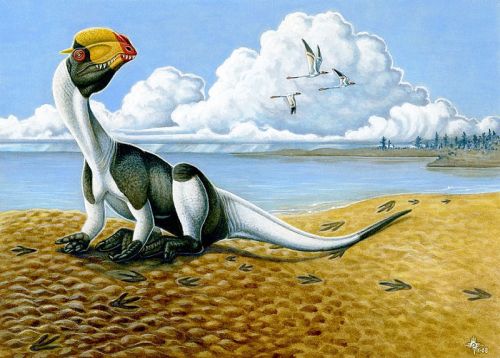 Restoration of Early Jurassic environment preserved at the SGDS, with the theropod Dilophosaurus wetherilli in bird-like resting pose, demonstrating the manufacture of SGDS.18.T1 resting trace. Artwork by Heather Kyoht Luterman, via Wikipedia, Creative Commons Attribution |
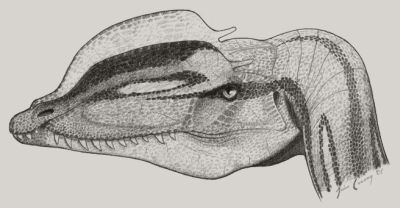 Dilophosaurus wethrelli, artwork © John Conway 2012. Creative Commons Attribution Non Commercial Non Derivative |
The Dilophosaurs are a cosmopolitan assemblage of early Jurassic theropod dinosaurs. These were large graceful bipedal preditors with lengths of 4 to 6 to 7 metres and estimated adult weights of 300 to 500 kg.. Originally included with Coelophysis and co in the Podokesauridae, they are generally now considered more closely related to more advanced theropods, so that the "Coelophysoidea" as conventionally defined constitute a paraphyletic and gradational stepwise series transitional between primitive and more advanced theropods (Smith et al 2007, Nesbitt 2011). There is still no agreement though as to whether the dilophosaurs themselves constitute a monophyletic clade (Yates 2006, Smith et al 2007, Xu et al 2009) or a paraphyletic grade between the Triassic ceolophysids and the middle Jurassic and later Averostra (Nesbitt et al 2009, Tom Holtz dendrogram). We have tentatively gone for the latter option as it fits the stratigraphic sequence better, although the former could also be true, in which case the averostrans would have been rare theropods alongside the successful dklophosaurs
At upto 6 or 7 meters in length, and 300 to 450 kg in weight, Dilophosaurs were both larger and more heavily built than even the biggest Triassic podokesaurs; it is likely that with the extinction of the large Rauisuchian thecodonts at the end of the Triassic, there were no large natural predators, so podokesaurs quickly grew to fill the role. Dinosaurs were to dominate the terrtrial top predator role for almost 150 million more years.
Not only were they larger, but they were also more evolved, aquiring characteristics absent in Triassic and early Jurassic Podokesaurs. According to Tom Holtz, dilophosaurs share several derived features (synapomorphies) with later theropods (averostrans), including: a lacrimal fenestra (airsac opening into the upper corner of the lacrimal), reduced total number of maxillary teeth, and modified jaw joint. This is just the hard skeletal characteristics, obviously there would have bene physiological and other changes as well. As yet there is no official name for the dilophosaur + averostra clade.

At one time it was thought that the large late Triassic carnivores such as Liliensternus, Lophostropheus and Gojirasaurus were included here, but the first two are now considered standard podokesaurs (coelophysids), and the last named has, unfortunately (because it has the coolest name - "Godzilla lizard") turned out to be a chimera, a mixture of rauisuchian thecodont, Coelophysis, and other elements (Nesbitt et al 2007). It may be that the large primitive coelophysids were killed off by the end Triassic mass extinction, to be replaced by more specialised types like the early Jurassic Dilophosaurus wetherilli, although, if Liliensternus is a transitional form (Nesbitt et al 2009) they may also constitute the ancestors of the dilophosaurs. MAK120208
Graphic: drawing of Dilophosaurus from Professor Paul Olsen's course notes
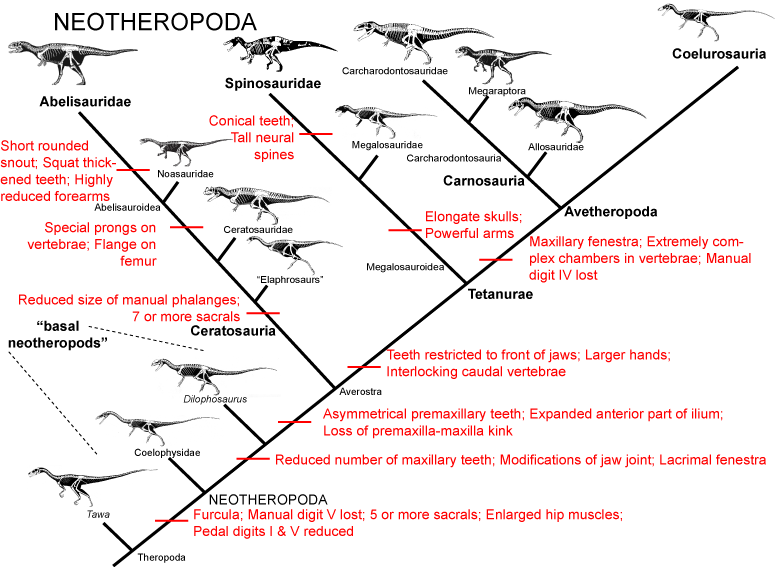 Simplified cladogram by Tom Holtz (Geology 104) showing the phylogenetic relationships and main synapomorphies of the Neotheropoda. Following a linear progressive development through basal theropods, coelophysids and dilophosaurs, the theropds diverged into two main lineages, the ceratosaurs and tetanurae, the latter of which further branched out into spinosaurs, allosaurs (here called carnosurs) and coelurosaurs. Each evolutionary stage is characterised by the loss or acquiring of various specialised characteristics (apomorphies). Determining the branching pattern (topology) of the cladogram is made more difficult by the independent acquiring of traits by different groups (convergences) as well as the loss of earlier traits (reversals). Recently, the discovery of the ostrich mimic Limusaurus (which would be located alongside Elaphrosaurus on this tree) has provided new insights regarding the loss of digits in the transition from theropod hand to bird wing. It was previously thought that digit IV was lost and the three inner ones retained, it is now known that theropods, in keeping with bird embryological development, lost the two outer digits I and V (the thumb and "pinkie"). Hence for example the avetheropoda (upper right of cladogram) are defined, among other things, by the loss of digit V (not IV) |
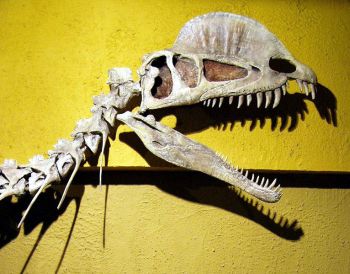 Dilophosaurus wetherilli, Royal Tyrrell Museum. Photo by Sebastian Bergmann, Flikr, Wikipedia, Creative Commons Attribution |
Dilophosaurus wetherilli (Welles, 1954)
Horizon: Kayenta Formation, Arizona (late Sinemurian / early Pliensbachian)
Phylogeny: Neotheropoda : Podokesauridae + Zupaysaurus + (Cryolophosaurus + "Dilophosaurus" sinensis + Dracovenator + Averostra + *)
Size: length 6 to 7 metres, weight: weight 300 to 450 kg (Paul 1988)
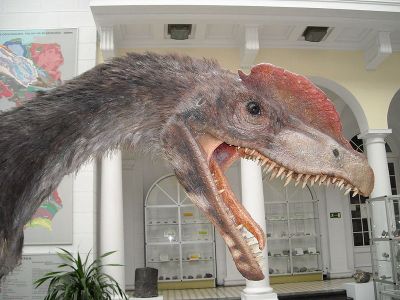 Head of a model of Dilophosaurus wetherilli nicknamed "Dyzio" in the Geological Museum of the Polish Geological Institute in Warsaw. Photography by Wikipek, via Wikipedia, Creative Commons Attribution |
Comments: The dominant preditor of the early Jurassic, more heavily built than earlier podokesaurs, this animal is distinguished by its large low build, large deep skull, unusually long teeth, and distinctive twin crests (left). Known from two possibly subadult skeletons, two skulls, additional partial skeleton and fragmentary remains .
This handsome animal has had the misfortune of being represented in the movie Jurassic Park as a sort ofdiminutive cross between a gremlin and a frill-necked lizard. Not only is the size in the movie version wrong, but the lower jaw is the wrong shape as well. The fallacy that the delicate head crests and "weak" snout (actually now known to be reinforced) only capable of made it unable to tackle live prey may also have led to the most unkely assumption (which first appears in Michael Chrichton's novel) that it spat poison (no archosaur is known to).
D. breedorum Welles vide Welles and Pickering, 1999 is probably a synonym. It has been suggested on basis of an imprint of a similarly-sized theropod sitting down that these animals may have been feathered.
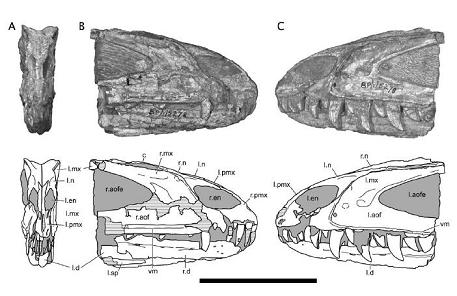
Dracovenator regenti Yates, 2006
Horizon: Upper Elliot Formation (Hettangian or Sinemurian)
Phylogeny: Neotheropoda : Podokesauridae + Zupaysaurus + (Cryolophosaurus + Dilophosaurus wetherilli + "Dilophosaurus" sinensis + Averostra + *)
Size: estimated 5.5 to 6.5 meters long
Comments: known from a partial skull, which displays a mosaic of podokesaur and advanced theropod characteristics. Cladistic analysis finds this taxon is closely related to Dilophosaurus and Zupaysaurus, although the clade formed by these three taxa is not robustly supported (Yates 2006)
Links Adam Yates blog - The Story of Dracovenator - Part 1, part 1; Dinosaur mailing list (abstract); Wikipedia
Image copied from Gigadino
.jpg)
"Dilophosaurus" sinensis Hu, 1993
Horizon: Lower Lufeng Series, Yunnan, China - Early Jurassic (Hettangian/Sinemurian/Pliensbachian)
Phylogeny: Neotheropoda : Podokesauridae + Zupaysaurus + (Cryolophosaurus + Dilophosaurus wetherilli + Dracovenator + Averostra + *)
Size: about 5 or 6 meters long
Comments: known from a skull and almost complete skeleton recovered from the Yunnan Province of China in 1987 (Hu1993), this animal was more heavily built than D. wetherilli, with an expanded scapula (shoulder blade) and taller, more robust pair of crests that are further forward on the skull. The kink in the upper jaw was not as noticable as in D. wetherilli, and the skull is somewhat similar to that of Ceratosaurus. It has been variously proposed that it is close to the tetaneura as it shares a number of synapomorphies (Irmis2004) a transitional form between Dilophosaurs and later theropods, or the most basal member of a monophyletic Dilophosauridae (Yates 2006). It may be closely reated to Cryolophosaurus (Wikipedia).
Image: Dilophosaurus sinensis, by Deviant Paleoart at en.wikipedia; Creative Commons Attribution-Share Alike license.
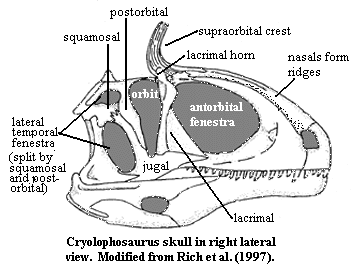 Cryolophosaurus ellioti Hammer and Hickerson, 1994; (informal senior synonym: Elvisaurus)
Cryolophosaurus ellioti Hammer and Hickerson, 1994; (informal senior synonym: Elvisaurus)
Horizon: Hanson Formation (Falla Formation), Central Transantarctic Mountains (Pliensbachian)
Phylogeny: Neotheropoda : Podokesauridae + Zupaysaurus + (Dilophosaurus wetherilli + "Dilophosaurus" sinensis + Dracovenator + Averostra + *)
Characters: Large (6-7 m) theropod. Skull 65 cm long; skull tall & narrow; large antorbital fenestra; nasals form ridges which merge with supraorbital crest; crest extends whole distance between orbits; crest mainly composed of lacrimal; 2 small lacrimal horns posterolateral to crest; lacrimal pneumatized; lateral temporal fenestra divided by processes of postorbital and squamosal; quadrate short; hindlimbs primitive. ATW010511
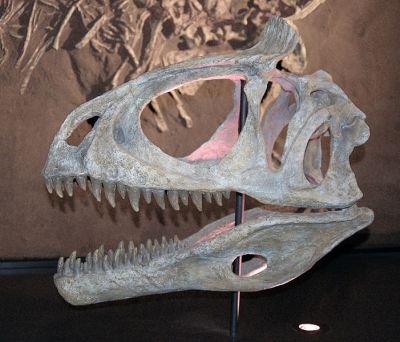
Comments: As the name implies, Cryolophosaurus is a crested theropod from a cold land. This in fact is misleading, because during the early Jurassic Antarctica was part of the vast temperate landmass of Gondwana. The first Antarctic dinosaur to be officially named, it was recovered from Mt. Kirkpatrick, a site at a paleolatitude of 61-70° S (presently 84° S). This animal was found in association with prosauropods (Smith et al 2007b). This advanced (for its time) animal was a contemporary of the big Dilophosaurs, but is more heavily built and provably had different feeding strategies. Cryolophosaurus was originally considered the oldest known Tetanuran, but later interpreted as a dilophosaur, either a derived member of monophyletic clade (Yates 2006, Smith et al 2007 or the sister taxon of a clade composed of Dilophosaurus and averostrans (Nesbitt et al 2009); in both hypotheses it is placed adjacent to Dilophosaurus. The skull is high and narrow, with a peculiar nasal crest runs just over the eyes, where it rises up perpendicular to the skull and fans out transversely (from side to side; unlike most Allosauroid and dilophosaur crests, seems to have been structured for anteroposterior, not lateral, display.). It is furrowed, giving it a comb-like appearance. No other theropod has this feature (either the crests run from front to rear, or they form small hornlets, or both), which raises the possibility that there might be some sort of post-mortem deformation, although the consensus is universally that this animal really did look like this. Owing to the resemblance of this structure to Elvis Presley's pompadour hairstyle in the 1950s, this dinosaur was at one point informally known as "Elvisaurus". MAK010506 120220
Links: Cryolophosaurus - DinoData; Cryolophosaurus; Cryolophosaurus by Keith Strasser; Cryolophosaurus (Dutch); Polar dinosaurs in Australia; Augustana Geology Department In Antarctica. ATW050619
References: Rich et al. (1997).
Image: Cast of a Cryolophosaurus ellioti skull at the Australian Museum, Sydney. Photo by Matt Martyniuk; Wikipedia, GNU Free Documentation/Creative Commons Attribution-Share Alike license. This cast and the above drawing may be quite speculative as only parts of the skull are known, it portays Cryolophosaurus as having Allosaurian proportions, something that would be very unlikely given our current understanding of the placement of this species. Greg Paul (2010) gives a more realistic dilophosaurian reconstruction, witha long low skull and kinked snout. MAK120220
Averostra Paul, 2002 : Ceratosauria + Tetanurae
Definition: Ceratosaurus nasicornis, Allosaurus fragilis and all the descendants of their most recent common ancestor; node-based (Ezcurra & Cuny 2007, Langer et al 2010)
Synonyms: Neotheropoda (sometimes)
Range: Middle Jurassic to Recent
Phylogeny: Neotheropoda : Podokesauridae + Zupaysaurus + (Cryolophosaurus + Dilophosaurus wetherilli + "Dilophosaurus" sinensis + Dracovenator + * : (Neo)Ceratosauria + Tetanurae)
Characters: Asymmetrical premaxillary teeth (not simple cones); Exapanded anterior end of the ilium, with a hook-like blade (Tom Holtz).
Comments: neotheropoda (avepoda) above the level of stem taxa (paraphyletic Podokesauridse / Coelophysoidea). Paul Sereno has criticised Greg Paul's apomorphy-based definition, but we are following the node-based definition of Ezcurra & Cuny 2007 and later workers. The name Averostra means "bird snouts", aesthetically this would be a nice complement to Greg Paul's Avepoda (so the feet evolve first for increased locomation, then the snouts for grasping prey). Quoting Tom Holtz: "The basal members of Ceratosauria and Tetanurae typically have mediolaterally narrow, dorsoventrally deep skulls: sometimes nicknamed "hatchet heads". This skull patterns is good for striking hard against a victim and slicing it up. However, it is not particulary strong if shaken back-and-forth, and so these dinosaurs probably did not hold onto their prey for very long with their jaws. This made primitive averostrans "bite-and-slice" feeders: they could carve chunks out of victims, or wound them, but could not hold onto them with their jaws." Generally more heavily built, and hence able to tackle larger prey, than their dilophosaur ancestors and predecessors. There do not seem to be any known stem Averostrans (averostrans that have not yet become Ceratosaurs or Tetanurae, although this is not surprising given the poor fossil record from this time. Future analyses, discoveries, and reinterpretations of already known taxa may fill out this group. Perhaps poorly known ambiguous taxa like Sarcosaurus may belong here. Tom Holtz (see previous link) suggests that the more powerful build of averostrans may be a co-evolutionary "arms race" with larger and more advanced herbivorous dinosaurs such as thyreophorans, iguanodontians, and eusauropods. In any case, ancestral Averostrans quickly evolved into two clades, the persitantly primitive true Ceratosaurs and the highly succesful and more bird-like Tetanurae. The former would dominate southern continents, the latter, nortthern. MAK120207
| Page Back | Unit Home | Page Top | Page Next |
checked ATW030913, page last modified MAK120208